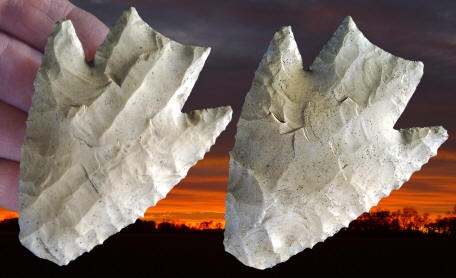|
LOWE
POINT
This is an excellent example of a Lowe point. It was found on the
type site location in northern Belize on the Lowe Ranch, where the name
for this point was borrowed. The Lowe point type and this point were
first illustrated and described in Kelly's report on "Preceramic
Projectile Point Typology In Belize." The sharply defined barbs, very
large parallel sided stem, and the long narrow flake removals from the
blade edge and base of the stem are some of this points most noticeable
features. "Classic" examples of Lowe points have sharply defined, massive and widely angled barbs. The
stems are ground on the edges and the stems also tend to be very large
and parallel sided and straight to concave on the basal ends. The
cutting edges are beveled from resharpening and often sharp
and
serrated. Some examples
were resharpened with parallel oblique flaking. Their most interesting
diagnostic trait are end thinning flake removals. The stems are
thinned from the base in a way that Kelly (1993) described as
"flake scars that are indistinguishable
from flute scars." Lowe points
are massive heavy duty beveled points that some suggest were probably
only used as knives. But it's very likely they were used for both
projectiles and knives. Many of them do have point impact damage.
This point is heavily patinated and is most probably made of Colha
chert. It measures 3 1/16 inches (7.7 cm) long and 2 1/4 inches (5.7 cm)
wide. |
